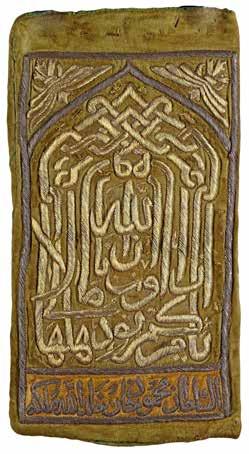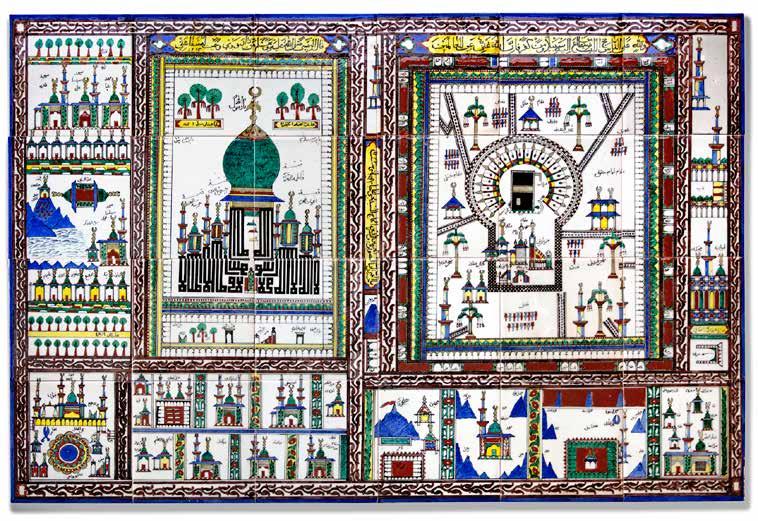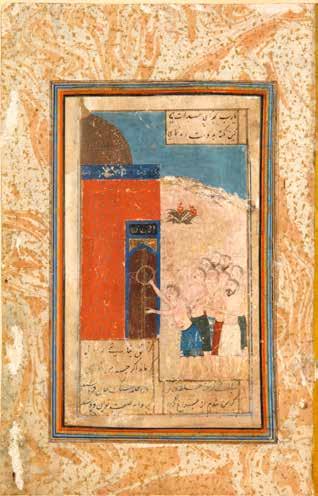
6 minute read
A LARGE MAMLUK REVIVAL SILVER AND COPPER INLAID BRASS TRAY DEPICTING THE MAHMAL PROCESSION TO MECCA, SYRIA, 19TH CENTURY
A brass tray of rectangular form, profusely inlaid, the central field depicting the Mahmal procession, the border containing cartouches enclosing inscriptions in thuluth script of Ayat Al-Kursi v. 255 from surah Al-Baqaraa with interspersed roundels containing bands enclosing kalimaat al-awhid.
The tray is decorated with a scene representing the procession of the mahmal, most probably after leaving Damascus as it is clear that the caravan is accompanied by Bedouin tribes for their good knowledge of the desert routes and protection against thugs and other tribes.The mahmal is borne by a richly caparisoned camel. It is preceded by an official holding a flag bearing the Ottoman star-and-crescent motif, and followed by another riding a similarly caparisoned camel and carrying a banner (bayraq). Behind him is a group of religious figures wearing distinctive hats. Around them are groups of soldiers riding camels or on horseback, three musicians and some pilgrims, as well as spectators and well-wishers. In the back ground is Amir al-hajj “commander of the pilgrimage” with other officials. 74 by 54 cm.
Advertisement
The mahmal was the ceremonial palanquin carried on a camel, which was the centre of the pilgrim caravan, and was the symbol of authority of the sultan over the holy places. Its origins are uncertain: it might hark back to the tradition of a palanquin carrying a high-ranking female accompanying military campaigns for encouragement, a role the Prophet’s wife was said to have had. The first sultan known to send the mahmal was Baybars (AD 1260-77). Following the Ottoman conquest of Egypt in 1517, the Ottomans also sent a mahmal from Damascus, as did the Yemenis on occasion. After the pilgrimage, the mahmal did not stay in Mecca, but was taken back to Cairo.
Estimate € 6000 - € 8000
Lot 184
AN OTTOMAN BLACK EMBROIDERED SILK KISWA, 19TH CENTURY
A fragment of the inner curtain of sacred kiswa for the inner wall of the Kabaa with an inscribed weave in cream-colored and gilt silk over a black ground. The crests of the chevrons are embellished with lamp motifs with circular medallions in between. Embellished with a group of three undulating bands which assume the form of a continuous chain made up of number ‘7’s. The bands run from the beginning to the end of the cloth. The central band with prominent Inscription of ‘Kalimaat al-Tawhid, There is no God but Allah and Muhammad is his Prophet’, repeating in the middle of the kiswa between the two zigzag bands. The two expressions, ‘Ya Mannan’ (O, the All-Bounteous) inside the upright lantern, and ‘Ya Hannan’ (O, the Most-Compassionate) inside the reversed lantern are also repeated with ‘Praise be to Allah’ (O, The All-sovereign) inside the circles. On the upper undulating band, there is a verse from the Quran surah Al-Ahzab v-56. The lower undulating band encloses another inscription of ‘prayers for the four righteous caliphs Abu Bakr, ‘Umar, ‘Uthman and ‘Ali as well as for the companions of the Prophet. 94 by 22 cm.
Estimate € 1200 - € 1500
Lot 185
AN OTTOMAN SILK KEY BAG EMBROIDERED WITH METAL-THREAD, TURKEY OR SYRIA
19TH CENTURY
Rectangular in shape, two dark green velvet panels stitched together, each side is heavily decorated with a thread of gold-plated and silver-plated lush decorations surrounding inscription in thuluth script of Quran 4 surah An-Nisa, verse 58 with the name of the Ottoman Sultan Mahmud II (r.1809-1839).

46 by 25.5 cm.
Estimate € 2000 - € 3000
Lot 186
KHARITAT AL-AJAIB WA FARIDAT AL-GHARAIB, ‘THE PEARL OF WONDERS AND UNIQUENESS OF STRANGE THINGS’ BY IBN AL-WARDI, DATED 1212 AH/1797 AD
Arabic manuscript on paper, 160 folios with 4 fly-folios and 19 lines to each page, written in black naskh script, titles and important words in red ink. Four paintings, gouache color heightened with gold, different ownership statements and seals, with a brown morocco leather binding, with ownership statements and seals.

15 by 23 cm.
Estimate € 10.000 - € 15.000
Catalogue Note
The book contains many chapters about geography and important places.The author summed up the geographical knowledge of the Arabic world of the time, referring to climate, terrain, fauna and flora, population, way of living, existing states and their governments in individual regions of the world. The work was accompanied by a colored world map and three illustrations of the Kaaba, in Al-Masij Al-Ha- ram surrounded by maqams and minaretes, the introduction about the distances, the earth and its divisions. Chapters mentioning countries, regions, seas. A chapter about Algeria and antiquities. A chapter about famous rivers, wells, and mountains. A chapter of the properties of stones and their benefits, minerals and gems and their properties. A chapter about plants ,fruits, grains, seed and their properties. A chapter about animals and birds and their properties. The conclusion of the book menti- ons the epics, the signs of yawm al-qyamah or the day of resurrection.

The author: Siraj al-din Abu Hafs Omar bin al-muzaffar bin al-Wardi who died in (852AH-1447AD). Ibn al-Wardi ,the grandson, was an agricultural scientist and geographer, wrote many books including this book, “Benefits of plants” and “Obligations and Benefits”.This book is mistakenly attributed to his grandfather but it was written in (822AH/1419AD) 71 year after the death of the grandfather.
The author
Siraj al-din Abu Hafs Omar bin al-muzaffar bin al-Wardi who died in 852 AH/1447 AD.
Ibn al-Wardi, the grandson, was an agricultural scientist and geographer, wrote many books including this book, ‘Benefits of plants’ and ‘Obligations and Benefits’. This book is mistakenly attributed to his grandfather but it was written in 822 AH/1419 AD 71 year after the death of the grandfather.
Lot 187
MAJNUN AT THE KAABA, SAFAVID PERSIA, FIRST QUARTER 16TH CENTURY
An illustrated folio from a Khamsa of Nizami, opaque pigments heightened with gold on paper, Majnun opens the door of the Kaaba surrounded by a crowd, four columns of text in nastaliq script above an below within gold rules, the text to the reverse laid out in rectangular text panels. 34 by 22 cm.

Catalogue Note
After being banned from seeing his childhood love Layla, Qays ibn al-Mulawwah’s obsessiveness drives him mad and makes him run away into the wilderness. His tribe gives him the epithet of Majnun (crazy). The scene of our jewel-like illustrated folio depicts Majnun’s father’s attempt to cure him, by taking him on pilgrimage to Mecca, to seek God’s help in freeing him. However, Majnun strikes the Kaaba and cries and demands to be allowed to love. He continues to wander in the wilderness, chanting poems about Layla’s love and beauty.
Estimate € 2000 - € 3000
Lot 188
AN OTTOMAN COMPASS AND QIBLA INDICATOR, 19TH CENTURY

A case, the frame painted in gold, decorated with a crescent moon and star in the center, opening in two parts. The inside of the cover painted with a central medallion representing aerial view of the al-Masdjid al-Harām mosque in Mecca, surrounded by a polychrome decoration of flowers and foliage on an ocher background. The inside of the box with a compass and compass rose in twelve directions, divided into degrees, with painted medallion view of the Al-Aqsa Mosque. This instrument, with the direction of the qibla positioned directly straight south, was made exclusively for Medina. To use it, orientate it by making the needle coincide with the northern minaret, then turn the box until the needle aligns with the direction of the qibla. The instrument can also be used to determine the true noon indicated when the string matches its own shadow on the meridian. At this time it also indicates true south, and therefore the direction of Mecca.With miniatures representing the sacred sites of Mecca.
Painted wood, brass hinges and closure.
26.3 cm by 17.9 cm.
Estimate € 6000 - € 8000
Lot 189
AN UNUSUAL KUTAHYA POTTERY PANEL DEPICTING A HAJJ MAP OF MECCA AND MEDINA, 19TH-EARLY 20TH CENTURY
The rectangular panel with 24 tiles, depicting the sites of Mecca and Medina, the location names inscribed in Naskh script in black ink, the panels bordered with scrolls throughout. 150 by 100 cm.


24 tiles
Estimate € 6000 - € 8000
Lot 190
AN OTTOMAN RED EMBROIDERED SILK KISWA, 19TH CENTURY
A fragment of the inner curtain of sacred kiswa for the inner wall of the Kaaba with an inscribed weave in cream-colored and gilt silk over a red ground. The crests of the chevrons are embellished with lamp motifs with circular medallions in between. Embellished with a group of three undulating bands which assume the form of a continuous chain made up of number ‘7’s. The bands run from the beginning to the end of the cloth. The central band with prominent Inscription of ‘Kalimaat al-Tawhid, There is no God but Allah and Muhammad is his Prophet’, repeating in the middle of the kiswa between the two zigzag bands. The two expressions, ‘Ya Mannan’ (O, the All-Bounteous) inside the upright lantern, and ‘Ya Hannan’ (O, the Most-Compassionate) inside the reversed lantern are also repeated with ‘Praise be to Allah’ (O, The All-sovereign) inside the circles. On the upper undulating band, there is a verse from the Quran surah Al-Ahzab v-56. The lower undulating band encloses another inscription of ‘prayers for the four righteous caliphs Abu Bakr, ‘Umar, ‘Uthman and ‘Ali as well as for the companions of the Prophet.
Estimate € 1200 - € 1500
Lot 191
MAJUN AT A SHRINE, PERSIA SAFAVID, 16TH CENTURY

An illustrated folio from a Khamsa of Nizami, opaque pigments heightened with gold on paper, Majnun opens the door of a maqam surrounded by a crowd, four columns of text in nastaliq script above and below within gold rules. All ruled in gold and polychrome borders. 23 by 15.5 cm. Text: 16 by 10 cm.
Estimate € 2000 - € 3000










